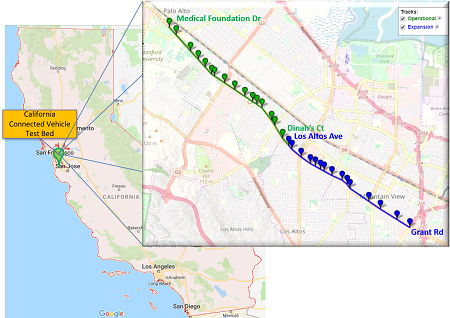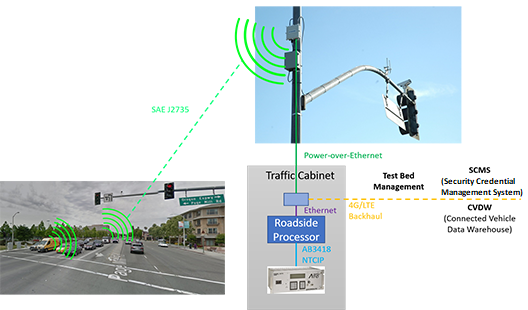The California Connected Vehicle Test Bed is located in the heart of the Silicon Valley in Palo Alto, California. The Test Bed spans 16 consecutive intersections along a three-mile stretch of State Route 82 (El Camino Real) and is in the process of adding 15 more intersections that bring its length to 7 miles. It provides an operational environment where intersections and vehicles can communicate through wireless connectivity.

USDOT provides a website on Connected Vehicle Basic as well as Knowledge Resources.
The Test Bed currently runs along El Camino Real in Palo Alto. It consists of 16 consecutive intersections between Medical Foundation Dr and Dinah's Ct in Palo Alto. The Test Bed exchanges live data with a Caltrans 2070 traffic controller at each intersection for populating the SPaT messages and commanding adaptive signal and priority timing. Traffic signals are operated and maintained by Caltrans District 4. The Test Bed is maintained and managed by the California PATH program.
The Test Bed is undeway of adding 15 more intersections. The expanded Test Bed consists of 31 consecutive intersections between Medical Foundation Dr in Palo Alto and Grant Rd in Mountain View.
Connected Vehicle Standards are rules that provide the software programming codes, definitions, and formats needed to create interoperable, consistent, and seamless communications exchange among shared information systems and devices. The Test Bed is using the latest version of SAE J2735 standard published March 30, 2016.
The connected vehicle system comprised of two parts:
OBUs communicate between themselves (V2V or Vehicle-to-Vehicle) and with RSUs (V2I or Vehicle-to-Infrastructure) using DSRC. The DSRC message sets transmitted between OBU and RSU, and their channel configurations are summarized in the table below.
| Message | Abbreviation | From | Frequency | To | Channel | PSID | DSRC Message ID |
|---|---|---|---|---|---|---|---|
| MAP/GID | MAP | RSU | 1 Hz | OBU | 180 | 0p80-02 (0x82) | 18 |
| Signal Phase and Timing | SPaT | 10 Hz | 19 | ||||
| Signal Status Message | SSM | 1 Hz | 0pE0-00-00-15 (0x20-40-95) | 30 | |||
| Basic Safety Message | BSM | OBU | 10 Hz | RSU | 180 | 0p20 (0x20) | 20 |
| Signal Request Message | SRM | Asynchronous | 0pE0-00-00-16 (0x20-40-96) | 29 | |||
| RTCM Corrections Message | RTCM | RSU | Type 1004 1 Hz | OBU | 180 | 0p80-00 (0x80) | 28 |
| Type 1012 1 Hz | |||||||
| Type 1006 1/15 Hz | |||||||
| Type 1007 1/15 Hz |
The Test Bed utilizes version 4.1 RSU hardware and software.
Each connected intersection has a 4G/LTE backhaul. The backhaul connection is currently used for PATH researchers to maintain and manage the Test Bed. It will be utilized to communicate with the Security Credential Management System (SCMS) in the near future. Caltrans and PATH do not archive Test Bed data.
At a connected vehicle intersection,
 the RSU is usually mounted on upright above the mast arm with DSRC radio antenna mounted on the mast arm.
The RSU is connected to the Roadside Processor through Power-over-Ethernet cable.
The Roadside Processor, installed inside the traffic cabinet, is a Linux-based industrial PC
which runs the roadside connected vehicle applications and communicates with the traffic signal controller
through a wired connection.
The Test Bed utilizes AB3418 protocol over RS232 for communications between the Roadside Processor and the controller.
We planed to add the capability to interface with NTCIP controllers.
the RSU is usually mounted on upright above the mast arm with DSRC radio antenna mounted on the mast arm.
The RSU is connected to the Roadside Processor through Power-over-Ethernet cable.
The Roadside Processor, installed inside the traffic cabinet, is a Linux-based industrial PC
which runs the roadside connected vehicle applications and communicates with the traffic signal controller
through a wired connection.
The Test Bed utilizes AB3418 protocol over RS232 for communications between the Roadside Processor and the controller.
We planed to add the capability to interface with NTCIP controllers.
The traffic controller pushes out signal status, vehicle call, and pedestrian call data to the Roadside Processor, at a rate of 10 Hz. The Roadside Processor estimates the phase remaining time, encodes SAE J2735 SPaT message payload and sends RSU the payload for broadcasting over-the-air. The Roadside Processor also stores the encoded SAE J2735 MAP payload which describes the geographic road information of the intersection and sends RSU the MAP payload for broadccasting over-the-air.
Please see Data Sample page for encoded MAP payload and sample encoded SPaT payload by intersection.
We support the use of MAP payload encoded by other tools, for example, the USDOT MAP Tool.
Please see Test Bed Status page for real-time status of the Test Bed.
Documentation is available at the Connected Vehicle Pooled Fund Study web site. In particular, the following documents from that web site are relevant to the California CV Testbed:
The source code is open source under the ECL-2.0 open source license and is available through USDOT Open Source Application Development Portal ( OSADP).